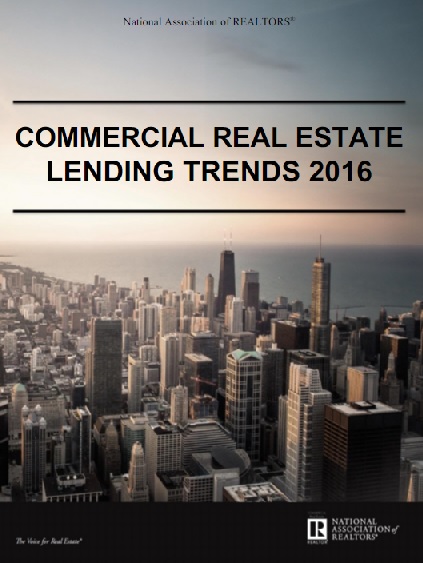NAR Recently released the 2016 Commercial Lending Trends Survey – see report intro and highlights below. CLICK HERE for the full report.
Commercial real estate (CRE) notched another year of growth in 2015, favored by continued macroeconomic growth and broadening capital markets, according to the Expectations & Market Realities in Real Estate 2016: Navigating through the Crosscurrents report, released by Deloitte, the National Association of REALTORS®, and Situs RERC. While global economies decelerated, leading to volatility in financial indices, U.S. gross domestic product rose, employment growth accelerated toward the tail end of the year, and housing prices reached new heights. In addition, the Federal Reserve signaled a shift in its monetary policy by raising its target funds rate, as core inflation hovered around its target of 2.0 percent.
Commercial vacancy rates declined for the core property types. Availability is expected to continue contracting for office, industrial and retail properties in 2016.Vacancies for apartments are estimated to rise, due to gains in supply. Commercial rents have risen across the board, and are projected to advance this year in the 2.5percent to 4.0 percent range.
CRE sales volume continued its positive trend in 2015, with $534 billion in closed transactions, compared with $432 billion in 2014, based on data from Real Capital Analytics (RCA). Most of the transactions reported by RCA are based on data aggregated at the top end of the market above $2.5 million.
In contrast to the large commercial transactions reported by RCA, commercial REALTORS® managed transactions averaging $1.8 million per deal, frequently located in secondary and tertiary markets, and focused on small businesses and entrepreneurs. The 2016 Commercial Real Estate Lending Trends shines the spotlight on this significant segment of the economy —a segment which tends to be somewhat obscured by reports on Class A trophy commercial properties.
Lending conditions in REALTOR® markets notched another year of sustainable recovery. As CRE asset prices strengthened, financing and lending conditions improved in 2015. The main sources of capital for commercial REALTORS®’ clients remained local and regional banks, which made up 55.7 percent of funding in 2015.The incidence of failed transactions, due to lack of financing, reached a new low.
REALTORS® cite uncertainty from legislative and regulatory initiatives as the most relevant cause of bank capital shortage for CRE.
Highlights
- Commercial real estate (CRE) notched another year of growth in 2015, favored by continued macroeconomic growth and broadening capital markets.
- Commercial vacancy rates declined for the core property types. Availability is expected to continue contracting for office, industrial and retail properties in 2016.
- Vacancies for apartments are estimated to rise, due to gains in supply.
- Commercial rents have risen across the board, and are projected to advance this year in the 2.5 percent to 4.0 percent range.
- Lending conditions in REALTOR® markets notched another year of sustainable recovery. As CRE asset prices strengthened, financing and lending conditions improved in 2015.